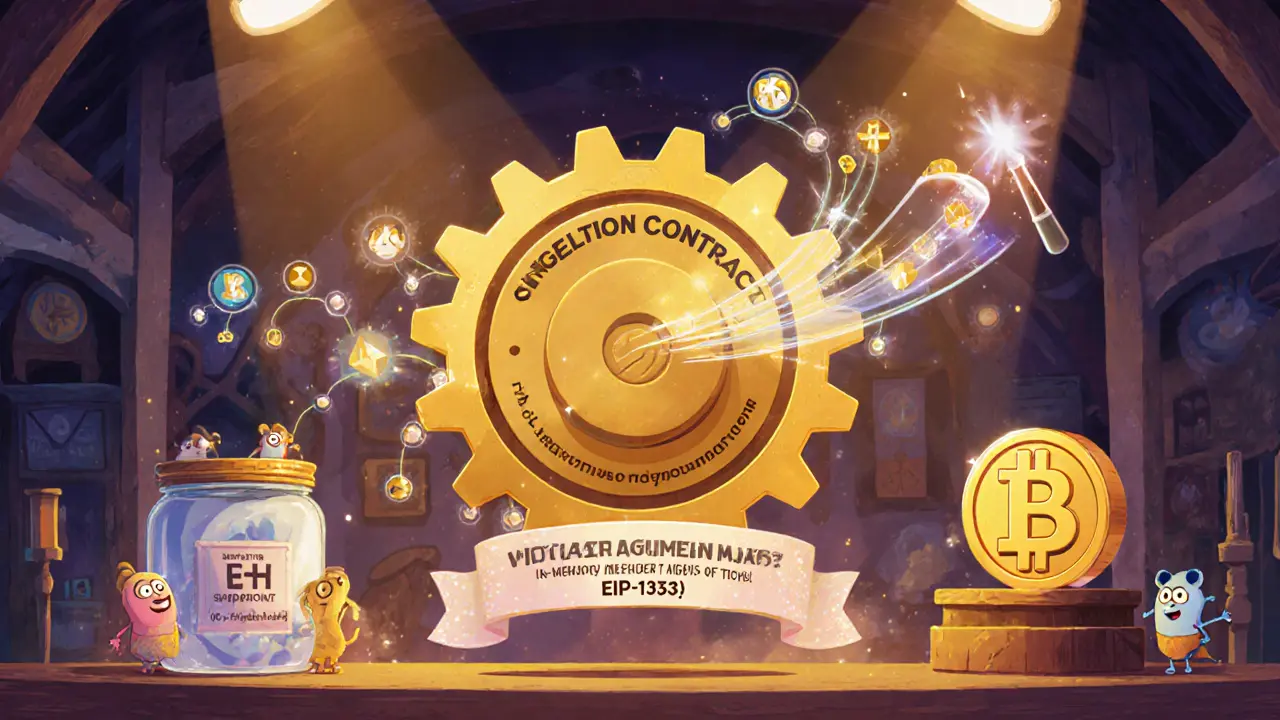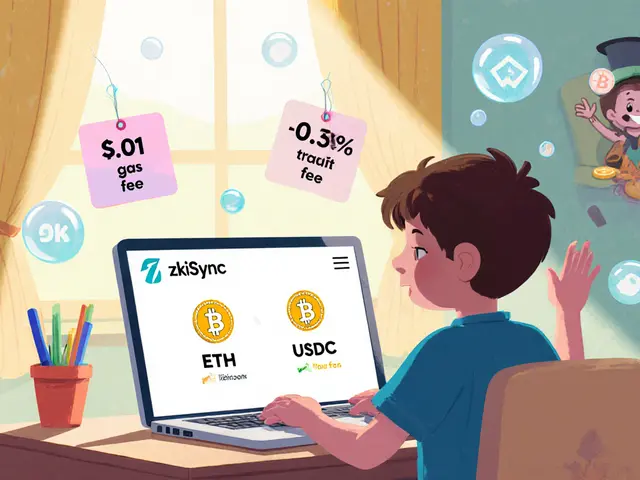When you type "Uniswap v4 (BSC)" into a search bar, you’re probably hoping to find a low‑fee, cross‑chain swap hub on Binance Smart Chain. The reality is a bit different: Uniswap V4 is the fourth major upgrade of the Uniswap protocol, built exclusively on Ethereum and its Layer‑2 networks. There is no official BSC version, and that distinction matters for gas costs, liquidity depth, and the kinds of custom features developers can build.
Key Takeaways
- Uniswap V4 runs only on Ethereum (mainnet, Arbitrum, Optimism, Base) - no native BSC support.
- Singleton contract architecture cuts pool‑creation gas by ~99.99%, making new pools cheap to launch.
- "Hooks" let developers add custom logic (fees, rebates, lending) but raise complexity and audit risk.
- Native ETH swaps remove the need for WETH, reducing swap fees by about 15% in tests.
- Compared to PancakeSwap V4 on BSC, Uniswap V4 offers deeper liquidity on Ethereum but requires bridges for cross‑chain moves.
Below we walk through the core innovations, compare them to the most common BSC DEX, and answer the questions most readers ask after spotting the "BSC" tag.
Why Uniswap V4 Isn’t on Binance Smart Chain
The original Uniswap code was written for the Ethereum Virtual Machine (Ethereum) and has stayed there through every upgrade. Official statements from Uniswap Labs, the OAK Research report, and multiple news outlets confirm that no BSC deployment exists. The protocol’s design depends on features like EIP‑1153 flash accounting that aren’t available on BSC, so a direct port would require a complete rewrite-something the team hasn’t pursued.
Technical Pillars of Uniswap V4
Three breakthroughs define the upgrade:
- Singleton contract system - Instead of spawning a fresh contract for every pool, a single universal contract now manages all pools. This slashes deployment gas from ~1.5million to ~15000, a 99.99% reduction.
- Flash accounting (EIP‑1153) - Tokens can be moved in‑memory during a transaction without costly intermediate approvals, letting multi‑step strategies execute in one atomic step.
- Native ETH support - Traders can swap ETH directly, avoiding the extra 0.003% fee that wrapping into WETH normally adds.
Each pillar is built on the Ethereum the world’s leading smart‑contract platform and is compatible with Layer‑2 solutions like Arbitrum, Optimism, and Base. The result is a faster, cheaper, and more flexible DEX.
Hooks: Custom Logic at Every Step
The most talked‑about feature is the hooks framework. Hooks are tiny contracts that run at predefined points: before a swap, after a swap, when liquidity is minted, or when it’s burned. Developers can program dynamic fees, rebates, or even isolated lending markets directly into the pool.
Pros:
- Fine‑grained fee control reacts to volatility in real time.
- New business models (e.g., fee‑return programs) become on‑chain.
- Integrations with other DeFi protocols can be seamless.
Cons:
- Each hook consumes a gas stipend; mis‑calculations can make swaps more expensive.
- Complexity spikes - developers need solid Solidity skills and thorough re‑entrancy testing.
- Audit costs rise because every custom hook is a new attack surface.
Community surveys show that 85% of V4‑related Discord questions revolve around hook implementation, and 63% of developers cite re‑entrancy protection as their biggest hurdle.

How Gas Savings Stack Up
According to Cointelegraph, a typical multi‑hop swap on V4 uses 30‑40% less gas than on V3. For most retail users, that translates to a few cents per transaction at current gas prices. Pool creation, the biggest single‑time expense, drops from roughly $0.70‑$1.10 to under $0.10 per pool.
When we line up the numbers against PancakeSwap V4 (the leading BSC DEX), the picture changes:
- Pool deployment cost reduction: Uniswap V4 99.99% vs. PancakeSwap V4 95%.
- Average swap gas: Uniswap V4 ~150,000 vs. PancakeSwap V4 ~120,000 (BSC’s lower base fee still makes absolute cost lower on BSC).
- Liquidity depth: Uniswap V4 holds $9.2B TVL (April2025) vs. PancakeSwap V4 ~ $6.8B.
Bottom line: If you need massive liquidity and are comfortable with Ethereum’s gas market, Uniswap V4 wins. If you want the cheapest raw gas and operate mainly on BSC, PancakeSwap remains attractive, but you’ll miss out on the custom hook ecosystem.
Real‑World Use Cases and Ecosystem Growth
Since launch, more than 140 protocols have built on the V4 hooks. A standout example is Silo Finance, which launched an isolated lending market using hooks to enforce collateral ratios. Within three months, it attracted $85M TVL and is projected to surpass $250M by Q32025.
Arbitrage bots have also taken advantage of the lower gas bill. A typical five‑hop arbitrage on V4 now costs roughly $0.25 in gas, versus $0.70 on V3, making marginal profit strategies viable again.
Risks, Regulatory Angles, and What to Watch
Advanced hooks can blur the line between a simple AMM and a regulated financial product. The SEC’s February2025 guidance hinted that certain dynamic fee mechanisms might be classified as securities. Uniswap Labs successfully argued that the protocol itself remains decentralized, but developers creating fee‑splitting hooks should stay aware of potential legal scrutiny.
Security is another concern. Tarun Chitra of Gauntlet warned that custom hooks introduce new attack vectors, especially when they interact with external lending contracts. Audits are now a must‑have for any production hook.
Finally, cross‑chain fragmentation persists. To move assets from Ethereum to BSC, you still need bridges like Symbiosis. Those bridges add latency and an extra layer of risk, which is why users looking for a truly one‑stop‑shop across chains still favor multi‑chain aggregators.

Comparison Table: Uniswap V4 vs. PancakeSwap V4
| Feature | Uniswap V4 | PancakeSwap V4 |
|---|---|---|
| Primary chain | Ethereum (mainnet & L2) | Binance Smart Chain |
| Pool deployment cost reduction | 99.99% (≈$0.07‑$0.12 per pool) | 95% (≈$0.30 per pool) |
| Average swap gas | ~150k (≈$0.35) | ~120k (≈$0.08) |
| Total Value Locked (TVL) | $9.2B (all versions) | $6.8B |
| Custom logic | Hooks framework (high flexibility) | Limited custom fee modules |
| Native ETH support | Yes (no WETH needed) | No (BNB only) |
| Cross‑chain swaps | Bridge required (e.g., Symbiosis) | Native BSC swaps; bridge needed for other chains |
How to Get Started on Uniswap V4
If you’re a trader, the steps are simple:
- Connect a Web3 wallet (MetaMask, Trust Wallet, etc.) to a supported Ethereum L2.
- Navigate to the official Uniswap interface and select the token pair.
- Confirm the swap - the interface will automatically use native ETH if you’re swapping ETH.
For developers wanting to launch a custom pool:
- Read the Uniswap V4 documentation (covers Hook templates).
- Clone the Uniswap V4 Periphery library from GitHub.
- Write and test your hook locally, then deploy via the singleton contract (≈15k gas).
- Submit the pool address to the UI or a front‑end you control.
Most developers report 2‑3 weeks of focused learning before they feel comfortable with hooks. The community Discord is a good place to ask quick questions; for enterprise‑grade support, Uniswap Labs offers a 48‑hour SLA for premium partners.
Frequently Asked Questions
Is there a Uniswap V4 version on Binance Smart Chain?
No. Uniswap V4 only runs on Ethereum and its Layer‑2 networks. Any reference to "BSC" is a misconception or a third‑party bridge solution.
What are the biggest gas savings with V4?
Pool creation costs drop from ~1.5million gas to ~15000 gas (≈99.99% reduction). Multi‑hop swaps use 30‑40% less gas than V3, saving a few cents per trade at current Ethereum rates.
Do I need to wrap ETH to trade on Uniswap V4?
No. V4 supports native ETH swaps, so you can trade directly without converting to WETH, which also cuts the swap fee by about 15%.
How do hooks affect security?
Hooks add custom code that executes during pool operations. While powerful, they create new attack vectors. Audits, proper re‑entrancy guards, and careful gas stipend management are essential before launching a hook‑enabled pool.
Can I use Uniswap V4 on other chains via a bridge?
Yes. Bridges like Symbiosis let you move assets from Ethereum to BSC, Polygon, or other EVM chains, but you’ll still be interacting with Uniswap on the Ethereum side. Bridge fees and latency apply.
Bottom Line
If you saw "Uniswap v4 (BSC)" and expected a Binance‑native DEX, you’ll be disappointed. The protocol lives on Ethereum, and that’s a good thing for anyone who needs deep liquidity, advanced custom features, and the security of the world’s most battle‑tested smart‑contract platform. The trade‑off is higher raw gas fees and the need for bridges when you want to hop over to BSC or other chains.
For traders who value cheap swaps and already operate on BSC, PancakeSwap V4 remains the go‑to. For developers seeking to innovate with hooks, or for traders needing the biggest pools and native ETH, Uniswap V4 delivers a compelling package. Knowing the chain difference helps you pick the right tool for your strategy.
Uniswap V4 review gives you the facts you need to decide whether to stay on Ethereum or look elsewhere.









Natasha Nelson
October 10, 2025 AT 21:26Wow, I just read this and I’m so confused… I thought Uniswap was on BSC? I’ve been using it there for months… I guess I’ve been scammed? Or maybe it’s a scam site? I’m so nervous now…
Sarah Hannay
October 11, 2025 AT 07:36It is important to clarify that Uniswap V4 is exclusively deployed on Ethereum and its Layer 2 ecosystems. The presence of third-party bridges or misleading search results does not constitute official protocol support. Misinformation of this nature may lead to unintended financial exposure and should be addressed with diligence.
Richard Williams
October 12, 2025 AT 05:45Hey, don’t stress if you got confused-this stuff is new and messy! The key thing is: if you’re on BSC, you’re NOT on Uniswap V4. You’re probably on a clone or bridge. But hey, that’s okay! Just double-check the contract address. I’ve been there too. You’re not alone.
Prabhleen Bhatti
October 12, 2025 AT 18:25Uniswap V4’s singleton architecture is revolutionary-EIP-1153 flash accounting enables atomic, gas-efficient state transitions without intermediate approvals, which fundamentally alters the liquidity provision paradigm. Hooks, while introducing reentrancy surface area, enable composable DeFi primitives like dynamic fee curves and embedded lending logic, which were previously only possible via external protocols. The TVL differential between Uniswap ($9.2B) and PancakeSwap ($6.8B) reflects the network effect of Ethereum’s composability stack, which BSC cannot replicate without EVM++ upgrades. Cross-chain liquidity fragmentation remains a systemic issue-bridges are trust-minimized but not trustless, and latency introduces MEV arbitrage windows. Developers must audit hooks rigorously-Gauntlet’s findings on hook-induced flash loan exploits are non-trivial.
Elizabeth Mitchell
October 13, 2025 AT 15:01Interesting read. I didn’t realize there was no BSC version. I’ve been using a site called ‘UniswapBSC’ and thought it was legit. Guess I’ll stick to PancakeSwap for now.
Chris Houser
October 13, 2025 AT 20:29For folks new to DeFi, the BSC confusion is super common. I’ve helped my cousin in Lagos set up his wallet-he thought Uniswap was on BSC too. The real win here is the gas savings on pool creation. 99.99% drop? That’s wild. Hooks are tricky, but if you’re building something, start with the template hooks. Community Discord is your best friend. You got this.
William Burns
October 14, 2025 AT 00:14It is regrettable that laypersons continue to conflate decentralized protocols with their bridge-based derivatives. The fact that one must explicitly state that Uniswap V4 does not exist on Binance Smart Chain underscores the alarming degeneration of financial literacy among retail participants. One cannot reasonably expect to participate in advanced DeFi infrastructure without understanding the fundamental architecture of the underlying blockchain. This is not a bug-it is a feature of the market’s immaturity.
Ashley Cecil
October 14, 2025 AT 14:58Uniswap V4 is not available on Binance Smart Chain. This is a factual, verifiable truth. Any website or individual claiming otherwise is either misinformed or intentionally deceptive. The use of the term ‘Uniswap V4 (BSC)’ is grammatically and technically incorrect. Please correct this misinformation immediately.
John E Owren
October 15, 2025 AT 09:57Gas savings are great, but I still don’t trust hooks. They feel like putting a flamethrower in your wallet. I’ve seen too many projects collapse because someone added a ‘cool’ feature that turned into a vulnerability. Stick to the basics. Native ETH swaps? Yes. Hooks? Not until they’ve been battle-tested for two years.
Joseph Eckelkamp
October 16, 2025 AT 01:19Of course Uniswap V4 isn’t on BSC. Why would it be? BSC is just Ethereum with a lower gas bill and a side of corporate sponsorship. The real innovation here is the singleton contract-finally, someone made deploying a pool cheaper than my Netflix subscription. Hooks? That’s just DeFi’s version of modding Skyrim. Some people will make beautiful mods. Others will make a mod that turns NPCs into screaming clowns. And someone will get hacked because of it. Classic.
Jennifer Rosada
October 16, 2025 AT 11:23It’s disturbing how easily people are misled into thinking DeFi protocols are cross-chain by default. This isn’t just ignorance-it’s negligence. If you’re using a platform that says ‘Uniswap V4 on BSC,’ you’re trusting a third party to relay your funds across chains. That’s not decentralization. That’s a ponzi with a whitepaper. You’re not a user-you’re a liability.
adam pop
October 16, 2025 AT 23:07Uniswap V4 on BSC? That’s a lie. They’re testing this to see who will click on fake links. Then they drain wallets. I know this because my cousin’s friend’s neighbor’s dog got hacked after clicking ‘Uniswap V4 BSC’-they lost 12 ETH. The government knows. They’re watching. Don’t trust anything that says ‘V4’ and ‘BSC’ together.
Dimitri Breiner
October 17, 2025 AT 17:32Love the breakdown. The 99.99% gas drop on pool creation is insane-I deployed a custom pool yesterday for $0.08. Hooks are scary, but if you’re building something that needs dynamic fees (like a yield aggregator), they’re the only way. Just don’t skip the audit. And yeah, bridges suck, but that’s why Layer 3s are coming. Ethereum’s ecosystem is still the only one that can do this.
LeAnn Dolly-Powell
October 18, 2025 AT 09:51Yesss!! Finally someone explained this clearly 😊 I was so confused because I kept seeing ads for ‘Uniswap on BSC’-now I know it’s just a bridge! Native ETH swaps are a game changer though-no more wrapping! I just swapped ETH for USDC and saved like 30 cents 🎉